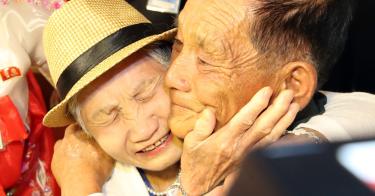A limited number of families from South and North Korea will be reunited at Mount Kumgang in North Korea this week. Family reunions are perhaps the most visible representation of the division of the Korean peninsula apart from the 38th parallel itself.
In most cases, the family members haven’t seen each other since the end of the Korean War in 1953. Some didn’t know their relatives were still alive until they were notified they had been selected for a reunion.
More than 132,000 people have registered with the Korean Red Cross to enter the lottery for family reunions since 1998. As of today, more than half of the individuals originally registered are deceased and an even higher percentage have reached an advanced age.
Many of the family members slated to participate in August 2018 reunions are elderly. Many believe this is their last chance to see North Korean relatives this side of heaven.
Fewer than 100 family members from each country were selected to participate in the August 20-26 reunions, where they will be permitted to meet with family members for mere hours. Past meetings permitted families to see each other for between six and eleven hours—hardly enough time to catch up on a lifetime of missed memories, hardships and joys that should have been shared had fate not separated them during the Korean War.
More than 20,000 people participated in the 20 family reunions held previously, predominately during the period of South Korean government’s “Sunshine Policy,” an era of increased engagement with North Korea under former South Korean president Kim Dae-jung’s presidency.
During the 2000 and 2007 inter-Korean summits, North Korea committed to “promptly resolve humanitarian issues such as exchange visits by separated family members” and to “expand reunion of separated family members … promote exchanges of video messages [and] regularize reunions.”
Family reunions are bittersweet. While it is certainly welcome that families have a chance to see one another, the only thing keeping them separated over all of these years has been authorities in Pyongyang. South Korea has the capacity to host family reunions every weekend, but North Korea consistently uses the reunions as a bargaining chip in negotiations and as a litmus test for the health of inter-Korean ties.
The brutal separation of Korean families is a reminder of the bloodshed during the Korean War, but perhaps more poignantly, also of the injustice of the Kim regime. No doubt, countless family members never had the chance at reunion because they were among the estimated 120,000 individuals imprisoned or the more than 400,000 who perished in North Korea’s modern-day gulags. Or perhaps they were among individuals publically executed for reading the Bible, watching South Korean dramas or disrespecting North Korea’s Dear Leader.
In an attempt to usher in reconciliation on the Korean peninsula, leaders in South Korea and the U.S. would be wise to remember that they are dealing with a shrewd and cruel dictator. Kim Jong-un’s human rights track record is just as bad, maybe even worse than his father's and his grandfather's, according to a report by Committee for Human Rights in North Korea.
South Korea’s Ministry of Unification announced their intent to host family reunions in late June, after the U.S. and North Korea concluded their first-ever summit between sitting leaders of the two countries on June 12. Reunions are a part of a broader thaw in inter-Korean relations that began just prior to the 2018 Pyeongchang Olympics.
Since then, North and South Korea already held an inter-Korean summit where they signed the Panmunjom Declaration, which included among other things, a stated interest in improving inter-Korean relations and a controversial commitment to move toward “complete denuclearization” of the Korean peninsula. Part of the agreement was to restart family reunions.
Family reunions are being held just prior to the third inter-Korean summit this year, expected to be held in September. South Korean President Moon Jae-in already stated that the goal of the upcoming inter-Korean summit was to make continued progress on denuclearization and to press North Korean counterparts to agree to a peace treaty officially ending the Korean War. After the Korean War that separated hundreds of thousands of family members, the two countries only signed an armistice and are technically still at war.
At present, progress on denuclearization is stalled after the Singapore Summit as the U.S. and North Korea struggle to reconcile differing definitions of denuclearization and put meat on the bare bones of the Singapore communique.
The upcoming family reunions serve as an unwelcome reminder of the division of the Korean peninsula, challenges in resolving the North Korean nuclear crisis, and the pain that the division and policy challenges cause to real people. Regardless, these reunions are one of the few moments that North and South will—albeit momentarily—attempt to put people over politics
This piece originally appeared in Forbes https://www.forbes.com/sites/oliviaenos/2018/08/20/what-bittersweet-family-reunions-mean-for-a-divided-korea/#f11ff37da707



